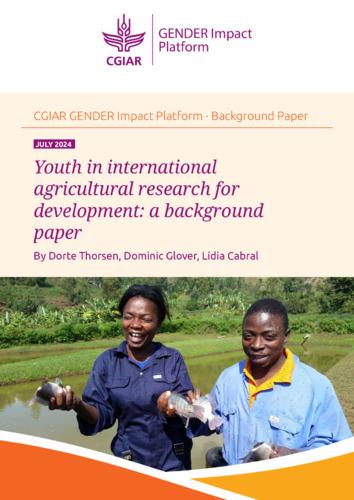Youth in international agricultural research for development: A background paper
Abstract
Youth is recognized as a key demographic in international agricultural and rural development. Although urbanization may absorb some of the youth population, agrifood systems will provide significant employment in the foreseeable future, notably in rural and peri-urban areas (Girard 2023; Dolislager et al. 2021). Young men and women hold large stakes in the future of sustainable agrifood systems, and they are recognized as an important target
group for agricultural research for development (AR4D) interventions. How then should the organizations that conduct and implement AR4D projects and programs engage with youth? How should these organizations orient themselves to include youth in the research process and be sensitized to their needs and priorities? How can they conduct research, and design and develop new technologies, in ways that take into account the different needs and capabilities of youth, as well as the social positions from which they act? How can AR4D activities be organized and focused to generate substantial benefits for youth?
This paper was commissioned by the CGIAR GENDER Impact Platform Its aim is to inform the Platform’s efforts to support the integration of a youth perspective within the agricultural and
food system research-for-development initiatives undertaken by CGIAR and its partners. The objective is to guide the GENDER Platform, CGIAR and its collaborators to conduct research
and develop new technologies that advance gender equality, take account of the variation in young people’s experiences, and create opportunities for youth within agricultural and food systems in low- and middle-income countries (LMICs). This defines the scope of the paper, which is addressed principally to the 15 CGIAR Research Centers, and their national and international partners, which conduct research and innovation activities that aim to contribute to agricultural and food systems transformation. The paper is also intended to be relevant and useful to other national, international, philanthropic and non-governmental organizations involved in the design, conduct or evaluation of AR4D programs.
This paper will assist CGIAR Centers—particularly those affiliated to the One CGIAR framework agreement—to realize their strategic aims and objectives with respect to youth. The paper will also be useful to other AR4D organizations and professionals involved in the design, implementation or evaluation of strategies, projects and programs across the agrifood domain because these programs typically involve or affect youth. A key objective of the One CGIAR Research Strategy to 2030 is to “offer rewarding opportunities to 267 million young people who are not in employment, education, or training (NEETs)” (CGIAR System Organization 2021, 19). This strategy extends the work done during the preceding strategy period, as the former CGIAR Research Programs (CRPs) all framed youth strategies in their second phases (2017–2022).

